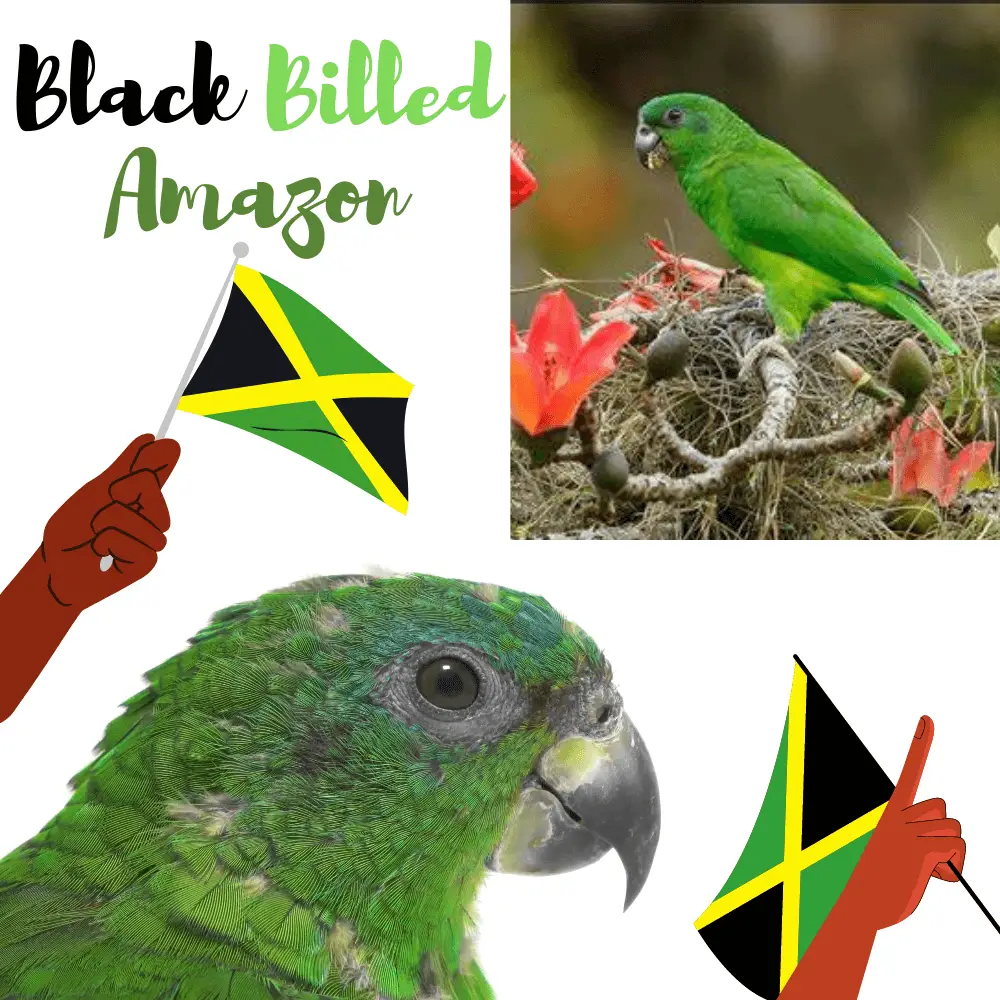
The Black-billed Amazon or Black-billed Parrot (Amazona agilis) is a species of bird in the Psittacidae family. It is one of the rarest species of the genus Amazona. Black-billed Amazon is green with small patches of red on the wing and flecked on the head
- Reign: Animal
- Fork:Chordata Sub-branching: Vertebrate
- Class: Poultry
- Order: Psittaciformes
- Family: Psittacidae
- Gender: Amazon
- Latin name:Amazona agilis
Description
This amazon parrot is smaller than the yellow-billed Amazon and measures between 26 and 29 centimeters. In males, the beak is very dark gray, almost black, becoming paler towards the base. The wax is very dark grey, as is the skin around the eyes, and the iris is dark brown.
The plumage of this bird is mainly green, paler, and yellowish on the lower parts. The feathers of the neck are lined with dark black. The ear covers are blackish and the primary covers are red. The primaries are blue-violet and black, and the secondaries are blue at the ends, becoming green towards the base.
The tail is mainly green, and the lateral feathers are marked with red, while the outer feathers are bordered with blue. The feet are greyish green.
Females are similar to males but with some green primary covers instead of red.
This species has predominantly green plumage with a bluish mark on the forehead and a bright blue wing band. At 25 cm tall, it is one of the smallest species of the genus Amazona. This bird has a clear sexual dimorphism since the male has a red mark on the wings absent in the female The ear covers are tinted black while the undercovers of the wings and the undercovers of the flight feathers are blue-green. Its feet and beak are greys. The irises are dark brown. Immatures have green primary remiges and dark irises.
Habitat
Black-billed Amazons live in the mountainous rainforest, usually, the limestone rainforest, feeding on fruits, seeds, and nuts, and consume cultivated fruits like mangoes, papayas, and cucumbers as well as wild fruits.
Natural habitat. This species is quite common in central Jamaica, from Cockpit Country to Mount Diablo. It is also found on the eastern slopes of the John Crow Mountains. This parrot occurs mainly in humid and limestone forests at the edge of the forest, especially at altitudes of 100 to 1400 m. It also uses cultivated land and plantations adjacent to the forest for food.
Captivity
In general, the breeding couple is housed in a large aviary 6m long by 2m wide and 2.5m high with a building 2m long by 2m wide and 2.5m high.
Longevity
Black-billed Amazon Parrot lives on average 55-60 years in captivity.
Behavior
These parrots have a calm temperament and can easily become confident with their guardians.
The courtship of the black-billed Amazon is different from that of other Amazons, in fact, the male swings next to the female with a movement of stiff and clumsy legs that will sometimes jump on the female.
These Amazon parrots are seen in small groups of up to 35 parrots. They blend into the canopy of the forest perfectly camouflaged by their green plumage where they are usually detected by their squeal calls.
Some behavioral problems can be observed in this species in captivity such as an excessive need to chew because, in the wild, they use their beak to “customize” their favorite tree or to enlarge the size of their nest in a hollow tree, so consider providing it with toys.
Feeding
In nature, its natural diet consists of seeds, nuts, and fruits.
Reproduction
Breeding takes place from March to August. The pair can use an abandoned Jamaican Woodpecker’s nest or a natural cavity dug by the weather. The female will lay 3-4 eggs there, which she will incubate for 26 days.
The young will leave the nest at about 8 weeks. Status in the Natural State. This species has a very small area in which its habitat is declining. Further population reductions are caused by trapping and predation.
Shifting agriculture, logging, and bauxite mining have reduced its habitat. Bauxite mining permits have recently been issued for more than 60% of the Cockpit Country Conservation Area, which supports more than 90% of the world’s population of this species. Predation of yellow boa is a limiting factor in nesting success. Conservation measures are being taken to safeguard this species.
This Amazon Parrot species is classified as Vulnerable on the IUCN Red List.
Population
The Black-billed Amazon was once as common as the Yellow-billed Amazon, but it has become much rarer due to deforestation and damage from hurricanes that fragment its forest, poaching for food, and the trade-in wild parrot pets.
Call
The call of the black-billed Amazon rings in flight though, while it is perched, it scolds and scolds. His screams often tend to be high-pitched and shrill.
SOURCE:Video Ark
Related Articles:




















